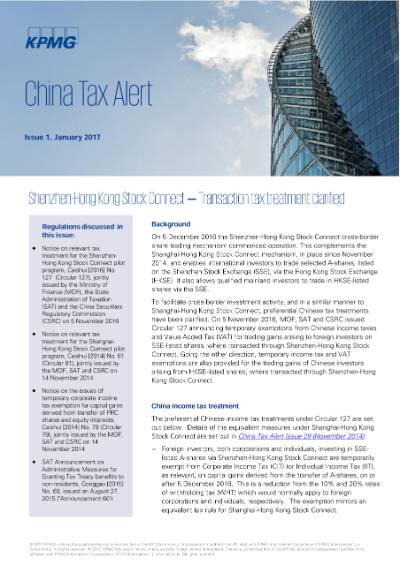- Home ›
- Shenzhen-Hong Kong Stock Connect – Transaction tax...
Shenzhen-Hong Kong Stock Connect – Transaction tax treatment clarified
Shenzhen-Hong Kong Stock Connect – Transaction tax...
China Tax Alert - Issue 1, January 2017

Background
On 5 December 2016 the Shenzhen-Hong Kong Stock Connect cross-border share trading mechanism commenced operation. This complements the Shanghai-Hong Kong Stock Connect mechanism, in place since November 2014, and enables international investors to trade selected A-shares, listed on the Shenzhen Stock Exchange (SSE), via the Hong Kong Stock Exchange (HKSE). It also allows qualified mainland investors to trade in HKSE-listed shares via the SSE.
To facilitate cross-border investment activity, and in a similar manner to Shanghai-Hong Kong Stock Connect, preferential Chinese tax treatments have been clarified. On 5 November 2016, Ministry of Finance, State Administration of Taxation and China Securities Regulatory Commission issued Circular 127 announcing temporary exemptions from Chinese income taxes and Value Added Tax (VAT) for trading gains arising to foreign investors on SSE-listed shares, where transacted through Shenzhen-Hong Kong Stock Connect. Going the other direction, temporary income tax and VAT exemptions are also provided for the trading gains of Chinese investors arising from HKSE-listed shares, where transacted through Shenzhen-Hong Kong Stock Connect.
China income tax treatment
The preferential Chinese income tax treatments under Circular 127 are set out below. Details of the equivalent measures under Shanghai-Hong Kong Stock Connect are set out in China Tax Alert Issue 29 (November 2014):
- Foreign investors, both corporations and individuals, investing in SSE-listed A-shares via Shenzhen-Hong Kong Stock Connect are temporarily exempt from Corporate Income Tax (CIT) (or Individual Income Tax (IIT), as relevant, on capital gains derived from the transfer of A-shares, on or after 5 December 2016. This is a reduction from the 10% and 20% rates of withholding tax (WHT) which would normally apply to foreign corporations and individuals, respectively. The exemption mirrors an equivalent tax rule for Shanghai-Hong Kong Stock Connect.
- With regard to dividends from A-shares, paid to foreign investors, Circular 127 simply states that dividends will be subject to 10% WHT, withheld at source. This treatment is the same as per Shanghai-Hong Kong Stock Connect. As the domestic rate of WHT applied to dividends paid to foreign corporations is 10%, this does not involve any tax reduction. It might be noted though that applicable domestic law WHT rate for individuals is 20%, so the clarification is of some assistance.
Where the recipient of the dividend is entitled to a lower tax treaty rate, Circular 127 notes that treaty relief may be obtained. Application can be made by the foreign investor, or the dividend paying Chinese corporation (as withholding agent), to the in-charge tax bureau of the payer for a WHT refund. It might be noted that most of China’s tax treaties provide for a dividend WHT rate of 10% on portfolio dividends, meaning that no effective treaty WHT reduction for corporate investors would normally arise. However, some of the newer Chinese tax treaties provide for much lower rates and there may be an emerging trend in this direction. WHT refund is the only mechanism currently available for treaty WHT relief as there are no system arrangements in place for SSE and HKSE to maintain relevant treaty relief information for foreign investors on file; if this were to change in future then treaty WHT relief at source could conceivably be possible. - Mainland individual investors will be temporarily exempt from IIT on disposal gains arising from HKSE-listed stocks for a period of three years from 5 December 2016 to 4 December 2019. However, they will continue to be subject to IIT at 20% on dividends received, as per domestic Chinese tax law. Foreign tax withheld on the dividends paid to the mainland individual investors may potentially give rise to a foreign tax credit in China. This treatment is the same as per Shanghai-Hong Kong Stock Connect. Equivalent tax treatment will also apply to mainland securities investment funds investing into Hong Kong shares via Shenzhen-Hong Kong Stock Connect.
- PRC corporate investors will not benefit from any exemption under Circular 127. They will continue to be subject to CIT at 25% on share trading gains on transactions conduction through Shenzhen-Hong Kong Stock Connect. They will also continue to be subject to CIT at 25% on dividends received from their Hong Kong stock investments. Foreign tax withheld on the dividends paid to the mainland corporate investors may potentially give rise to a foreign tax credit in China. This treatment is the same as per Shanghai-Hong Kong Stock Connect.
This being said, if the investment is in H-shares (i.e. shares in Chinese enterprises listed on the HKSE), and if the shares are held for more than 12 months, then these will be tax exempt, subject to certain administrative requirements.
China VAT and Stamp Duty treatment
Circular 127 provides that foreign investors, both corporations and individuals, which purchase and sell SSE-listed A-shares via Shenzhen-Hong Kong Stock Connect, are temporarily exempt from China VAT. Chinese investors, buying and selling shares through the HKSE via Stock Connect, are similarly exempted from China VAT.
When the tax rules for Shanghai-Hong Kong Stock Connect were clarified in 2014, the equivalent tax exemption provision had applied to business tax (BT). BT was replaced with VAT for all financial services sector transactions from May 2016, and so Circular 127 addresses itself to VAT implications. Previous clarifications had already transitioned the Shanghai-Hong Kong Stock Connect BT exemption to a VAT exemption.
Circular 127 provides that the stamp duty treatment of share transfer transactions in both directions (i.e. both dealings in shares on the SSE and on the HKSE) will be as normal, with no exemptions provided. However, stock borrowing arrangements designed to cover short sales are noted to be stamp duty exempt. This treatment covers not just transactions relevant to Shenzhen-Hong Kong Stock Connect, but is also extended to transactions relevant to Shanghai-Hong Kong Stock Connect (this exemption was not a feature of the 2014 tax guidance).
Summary of Stock Connect tax treatments
A summary of tax implications for Hong Kong and foreign investors and PRC investors are set out below:
| Investors via Stock Connect | PRC IIT/CIT | PRC VAT | Stamp Duty (SD) | ||
|---|---|---|---|---|---|
| Capital Gains |
Dividends | ||||
| Foreign investors in SSE shares | Indiv./ Corp | Temp. exempt | WHT at 10% (subject to DTA relief) | Temp. exempt |
PRC SD applies(0.1% for seller on A-share transfer). Exemption for certain stock borrowing. |
| PRC investors in HKSE shares | Indiv. | Temp. IIT exempt for 3 years | IIT at 20% | Temp. exempt |
HK SD applies. Exemption for certain stock borrowing. |
| Corp. | CIT at 25% | CIT at 25% (other than H shares) | Taxable or exempted (existing rules) |
||
KPMG observations
The launch of Shenzhen-Hong Kong Stock Connect provides another important pillar for the arrangements facilitating cross-border investment in listed securities, to and from China. The two Stock Connect programs sit alongside the existing Qualified Foreign Institutional Investor (QFII) and Renminbi QFII (RQFII) programs, whose tax treatment was clarified in 2014 with Circular 79 which provided for exemption of investment disposal gains.
As was previously the case with the 2014 Circular 81 tax guidance for Shanghai-Hong Kong Stock Connect, Circular 127 provides important support for the effective operation of Shenzhen-Hong Kong Stock Connect. The clarified rules bring a number of benefits:
- With regards to the China CIT/IIT treatment of capital gains arising to foreign investors on trading in SSE-listed A-shares, Circular 127 provides clear exemption treatment.
A number of Chinese tax treaties exempt gains from disposals of (non-land rich) portfolio shareholdings from Chinese income tax, and an increasing number of more recent treaties exempt gains on trading of listed shares, even where these are land-rich. However, obtaining treaty relief is a cumbersome and uncertain process in China, and the Circular 127 exemption greatly simplifies matters, alongside the equivalent exemptions for Shanghai-Hong Kong Stock Connect and for QFII/RQFII arrangements.
Stock Connect solely allows for investment in A-shares, though investment in other forms of listed investment (e.g. bonds, futures, units in Chinese mutual funds) are possible for QFII/RQFII. As no exemption is provides for disposal gains on these, resort must still be had to treaty relief in these cases. - With regards to dividend payments, Circular 127 notes that tax refunds will be available where treaties permit WHT reductions. Guidance on treaty WHT refunds was already set out in SAT Announcement 60 [2015], but it is helpful, from the administrative point of view of dealing with the tax authorities, for the guidance on refunds to be reiterated in Circular 127. It might be noted that newer China tax treaties are securing very low rates of WHT on portfolio dividends for investors, so this could be increasingly useful in future.-
- The clarification of the VAT exemption position for purchase and sale of A-shares through SSE is helpful. However it might be noted that the sale through the SSE of shares not previously purchased through the SSE (e.g. pre-listing purchase) would not be so exempt.
- While the Stock Connect programs just cover A-shares, a broader range of investments is possible through QFII/RQFII and further guidance is still needed in respect of the VAT position for futures and other financial products traded through the latter.
The tax guidance for Shenzhen-Hong Kong Stock Connect has, as with the 2014 guidance for Shanghai-Hong Kong Stock Connect, provided for the inbound investment CIT/IIT and VAT exemptions to be “temporary” in nature. No time limit has been placed on these and it remains to be seen, as with the 2014 exemptions, for how long these are kept in place. Some commentators refer to the 3-year IIT exemption granted to Chinese individual investors as perhaps indicative of the lifetime of the exemptions for the foreign investors. However, under Chinese tax law “temporary” exemptions frequently do run for very extensive periods - the existing IIT exemption for Chinese individuals trading A-shares, granted in 1998 and still in force, might be referred to in this regard.
© 2025 KPMG Huazhen LLP, a People's Republic of China partnership, KPMG Advisory (China) Limited, a limited liability company in Chinese Mainland, KPMG, a Macau SAR partnership, and KPMG, a Hong Kong SAR partnership, are member firms of the KPMG global organisation of independent member firms affiliated with KPMG International Limited, a private English company limited by guarantee. All rights reserved.
The KPMG name and logo are trademarks used under license by the
independent member firms of the KPMG global organisation.
For more detail about the structure of the KPMG global organisation please visit https://kpmg.com/governance.
Connect with us
- Find office locations kpmg.findOfficeLocations
- kpmg.emailUs
- Social media @ KPMG kpmg.socialMedia
Stay up to date with what matters to you
Gain access to personalized content based on your interests by signing up today

